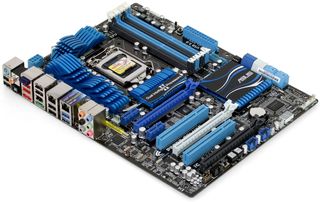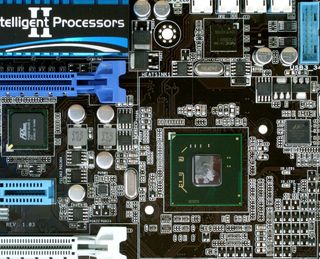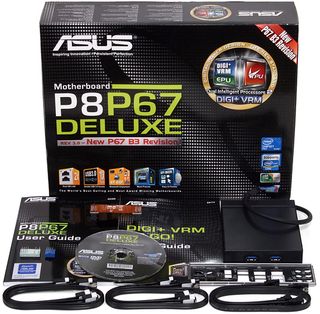High-End P67 Express: Five $200-250 Motherboards
With mainstream boards based on Intel's P67 Express chipset now priced well beyond $150, we reached into the $200-250 range to see what kinds of enhancements high-end buyers could expect just ahead of the anticipated Z68 Express launch.
Asus P8P67 Deluxe
An integrated Bluetooth transceiver and separate eSATA controller are two things that set Asus’ P8P67 Deluxe apart from its value-oriented competitor. Of course, you have to give something else up, and the P8P67 Deluxe only has two rear-panel USB 3.0 ports.

Four additional USB 2.0 ports have been moved from front-panel headers to the rear I/O panel, replacing one of the PS/2 and two of the USB 3.0 ports seen on ASRock's boards. That leaves only two USB 2.0 headers (four ports) internally, though that number has sustained most builders through several motherboard generations, and we don't expect any changes now. Those who need more front-panel USB will find a two-port USB 3.0 header.

That two-port USB 3.0 header also marks a big difference from competing products by being placed front-and-center, just behind the 3.5” external bay of most cases. Asus still places its front-panel audio connector in the bottom-rear corner, however.
Asus does not offer any Ultra ATA or floppy connectors, even though the floppy controller is present in its Multi-I/O controller. Leaving the connector out does clean up the board’s layout a little, and the combined market for both interfaces is far too small to consider removal a mark against value.
Asus even uses the same slot layout as ASRock, switching from x16-x0-x4 to x8-x8-x4 transfer modes automatically whenever a card is installed in its second x16-length slot.

Things look quite a bit different under the sinks, though. Performing traditional southbridge functionality, Intel's P67 PCH is placed in the traditional southbridge location. Next to it, the PEX8608 eight-lane bridge distributes the bandwidth of four lanes not used by the third graphics slot across two PCIe x1 slots and several interface controllers. Those controllers include two SATA, two USB 3.0, one Ethernet, and one FireWire controller.
The P8P67 Deluxe’s primary network controller is not a PCIe-based device. Asus uses Intel’s WG82579V PHY to interface the chipset’s network function directly, purportedly reducing latency and simultaneously saving the board from running out of PCIe lanes.
Stay on the Cutting Edge
Join the experts who read Tom's Hardware for the inside track on enthusiast PC tech news — and have for over 25 years. We'll send breaking news and in-depth reviews of CPUs, GPUs, AI, maker hardware and more straight to your inbox.

The P8P67 Deluxe includes six internal SATA cables, four of which are rated compliant with the SATA 6Gb/s specification. Asus’ USB 3.0 front-panel 3.5” external bay adapter is fully boxed (rather than open-topped), adding expense while eliminating its ability to be used as a 2.5” drive adapter.
-
joytech22 So glad I grabbed my P8P67 Deluxe!Reply
It had all the features I was looking for at a low enough price to make it very appealing. -
Crashman rolli59Nice article would have been nice to have a Gigabyte board in there as well.Please tell Gigabyte to produce something for this market!Reply
Tom's Hardware included the UD4 in its $150-200 motherboard roundup, and the UD5 costs more than $250. -
Manos How te hell is it possible that a website like this keeps ignoring my question as in WHY its been for so many months if not year or whatever, that they dont fix this *** and I cant click to submit my comment from IE? How can THIS be the only website with issues with IE? I find it rather sad. Its why i quit commenting instead of being forced to open a different browser for this site which I used to love and respect. Till they started ignoring this issue Ive been pointing out ( and not just me ).Reply
Thank you for the charts tho id love to see one with Maximus IV included x.x ( I edited cause I asked something stupid as in why I dont see it in the chart. Sorry.. Been working all night and no time to read the article. Bits only.And no I obviously hadnt read the title x.x My bad. Happy Easter! -
jerreddredd It would have been nice to see if there is a performance gain in these "high end" boards over a value P67 board.Reply
For an even better article also throw in one of each value rated H67 and H61 boards. ($240 vs $130 vs $70 boards)
-
alidan jerreddreddIt would have been nice to see if there is a performance gain in these "high end" boards over a value P67 board. For an even better article also throw in one of each value rated H67 and H61 boards. ($240 vs $130 vs $70 boards)this, i would love to see how the high end stacks up with the low end. the low may not have as much as the high end, but performance is really all that matters considering we can just get expansion cards for things we dont have.Reply -
Hupiscratch Great article. Now it´s time for the high-end overclocking oriented boards, like the ASUS Maximus IV Extreme.Reply -
memadmax I'm gonna go all out on this chipset when it matures a bit. A cool 5 grand i'm thinking for my next gen build.Reply
Most Popular


